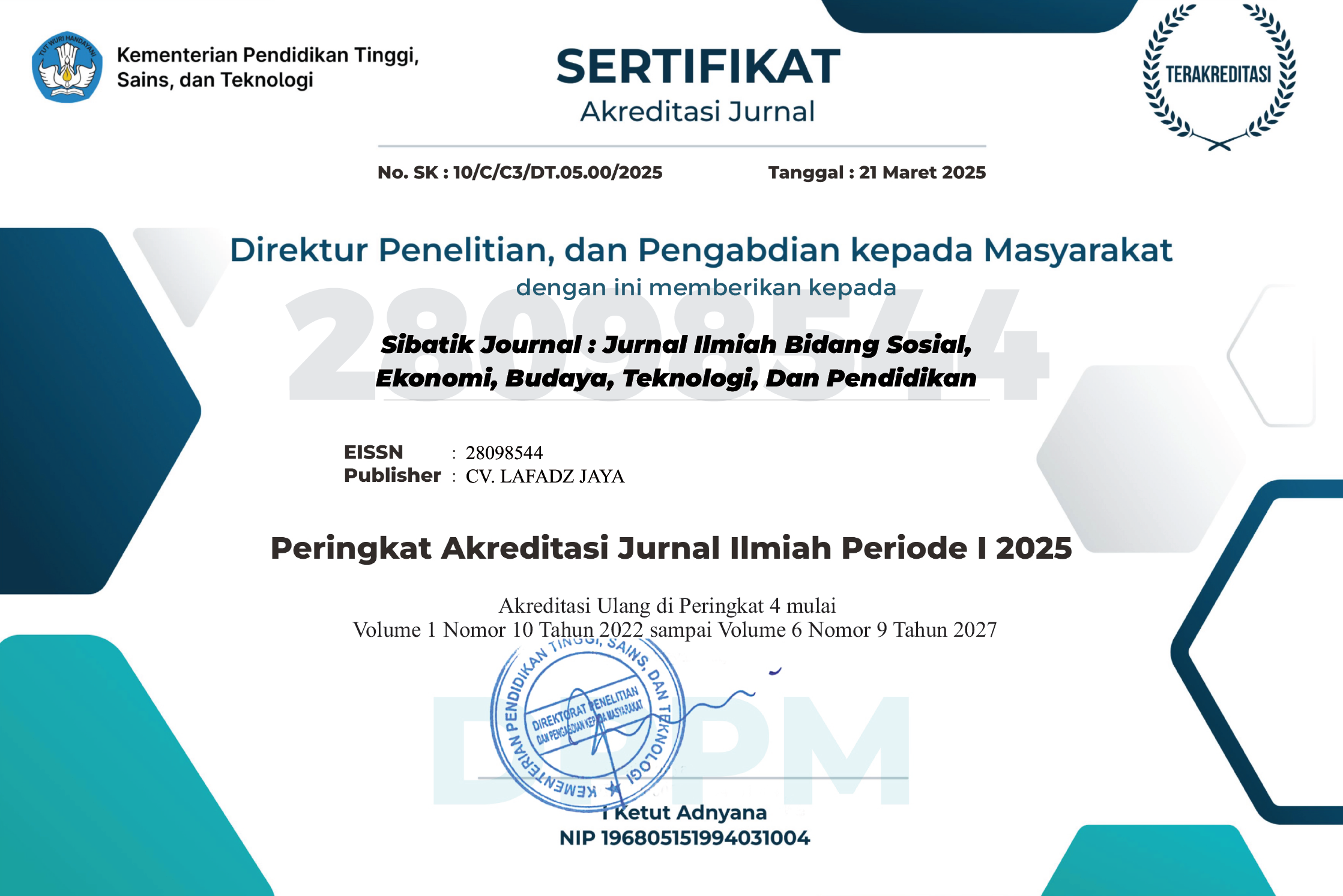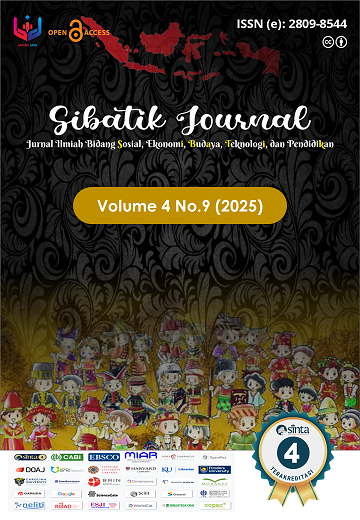HUBUNGAN SMARTPHONE ADDICTION DENGAN SIKAP APATIS SISWA SMP
Main Article Content
Fuji Lestari
Afdal
Frischa Meivilona Yendi
Gusni Dian Suri
This study examines the relationship between smartphone addiction and apathetic behavior in junior high school students. Using a quantitative correlational method, a sample of 280 students was selected by simple random sampling. Data were collected through valid and reliable instruments, then analyzed using descriptive percentages and product moment correlations. The results showed that the level of smartphone addiction and apathetic behavior was in the moderate category with a percentage of smartphone addiction of 67.85% and apathy of 69.28%. There was also a positive and significant relationship with a correlation coefficient of 0.481, included in the moderate relationship category with a significance level of 0.000, which indicates that the higher the smartphone addiction, the higher the apathetic behavior of students. These findings serve as a reference for guidance and counseling services to reduce apathetic behavior due to smartphone addiction, one of the guidelines in providing guidance and counseling services in schools, especially in individual counseling services, group guidance, and information services to reduce smartphone addiction and prevent the emergence of apathetic behavior in students.
Alma, Buchari. (2010). Pembelajaran Studi Social. Bandung: Alfabeta.
Alwisol. (2009). Psikologi Kepribadian Edisi Revisi. Malang: UMM Press
American Psychiatric Association. (2013). Diagnostic and statistical manual of mental disorders (5th ed.). Arlington, VA: American Psychiatric Association.
Andi Asari, Donal Nababan, A. P. O. A., Jiarti Kusbandiyah, Nana Citrawati Lestari, Lesi Hertati, M., Baiq Fina Farlina, Aditya Pandowo, M. L. P., & Zulkarnaini, A. N. A. A. (2023). Dasar Penelitian Kuantitaif.
Arnadi. (2016). Analisis Faktor Pembentuk Sikap Apatisme Mahasiswa Pada Partai Politik. Digilib.
Azwar, Saifuddin. (2011). Sikap Manusia Teori dan Pengukurannya, edisi kedua. Yogjakarta: Pustaka pelajar
Bintari, R. H. (2020). KECANDUAN GADGET DI MASA PANDEMI COVID-19 PADA SISWA KELAS XII MIPA SMAN 1 SUTOJAYAN KABUPATEN BLITAR Prodi Keperawatan Institut Tekonologi Sains dan Kesehatan RS dr . Soepraoen Malang LATARBELAKANG Saat ini dunia kategori tinggi , 120 orang siswa ( 50 %). 8(2).
Chiu, Shao-I. (2014). The relationship between life stress and smartphone addiction on taiwanese university student: A meditation model of learning self efficacy and social efficacy. Computers in Human Behavior ,34, (2014) 49-57
Clarisa, D., Ides, S. A., & Surianto, F. (2022). Hubungan Tingkat Penggunaan Media Sosial, Intensitas Penggunaan Media Sosial dengan Interaksi Sosial pada Remaja di SMK X. Jurnal Keperawatan, 3(2).
Ertemel, A. V., & Ari, E. (2020). A Marketing Approach to a Psychological Problem: Problematic Smartphone Use on Adolescents. International Journal of Environmental Research and Public Health, 17(7), 2471.
Fraenkel, J. R., & N.E, W. (2008). How to Design and Evaluate Research in Education. McGraw-Hill
Hurlock, E. B. (2011). Psikologi perkembangan: Suatu pendekatan sepanjang rentang kehidupan (Alih bahasa: Istiwidayanti & Soedjarwo). Jakarta: Erlangga.
Harahap, L. A. A., & Dewi, I. S. (2021). Layanan Bimbingan Kelompok Melalui Teknik Sosiodrama dalam Mengurangi Kecanduan Gadget pada Siswa. Syifaul Qulub: Jurnal Bimbingan Dan Konseling Islam, 2(2), 88-95.
Irnawaty, & Agustang, A. (2019). Smartphone Addiction Pada Mahasiswa Pendidikan Sosiologi Fakultas Ilmu Sosial Universitas Negeri Makassar. Jurnal Sosialisasi Pendidikan Sosiologi, 6(2), 41–46.
Izzah, U. (2021). Pengaruh Layanan Informasi Terhadap Penggunaan Gadget Bagi Siswa SMP Negeri 7 Banda Aceh (Doctoral dissertation, UIN Ar-Raniry).
Kartono, K. (2005). Teori kepribadian. Mandar Maja.
Krisnila, K., & Putra, A. R. B. (2017). Analisis Sikap Apatis Peserta Didik Kelas XI Sar-1 di SMK Negeri 2 Palangka Raya. Suluh: Jurnal Bimbingan dan Konseling, 2(2), 32-38.
Kwon, M., Kim, D. J., Cho, H., & Yang, S. (2013). The smartphone addiction scale: Development and validation of a short version for adolescents. PLoS ONE, 8(12), 1–7.
Leung, L. (2007). Linking psychological attributes to addiction and improper use of the mobile phone among adolescents in Hong Kong. Journal of Children and Media, 2(2), 93–113.
Lin, Y. H., Chiang, C. L., Lin, P. H., Chang, L. R., Ko, C. H., Lee, Y. H., & Lin, S. H. (2016). Proposed diagnostic criteria for Smartphone addiction. PLoS ONE, 11(11), 1–11.
Maslim, R. (2013). Diagnosis gangguan jiwa: Rujukan singkat PPDGJ III dan DSM 5 (Buku saku) (Cet. ke-2). Jakarta: Bagian Ilmu Kedokteran Jiwa, FK Unika Atmajaya.
Melina, E. (2024). Pengaruh Smartphone Addiction Terhadap Academic Performance Dimediasi Motivasi Belajar Pada Siswa.
Nasrullah, R. (2015). Media Sosial: Perspektif Komunikasi, Budaya, dan Sosioteknologi. Bandung: Simbiosa Rekatama Media.
Putra, A., Ifdil, I., & Afdal, A. (2019). Deskripsi tingkat kecanduan smartphone berdasarkan minat sosial. Jurnal Aplikasi IPTEK Indonesia, 3(1), 9-16.
Park, B.-W., & Lee, K.-C. (2011). The effect of users’ characteristics and experiential factors on the compulsive usage of the smartphone. Dalam Ubiquitous Computing and Multimedia Applications (hal. 438–446). Berlin & Heidelberg: Springer.
Prasetyo, A. (2018). Sosial Siswa Kelas X Smk Kristen Bm ( Bisnis Dan Tugas Akhir).
Prayitno. (2012). Jenis Layanan Dan Kegiatan Pendukung Konseling. Padang:Universitas Negeri Padang.
Prayitno. (2004). Layanan Bimbingan Konseling Kelompok. Padang: Jurusan Bimbingan Dan Konseling Fakultas Ilmu Pendidikan UNP
Pratama, B. A., & Sari, D. S. (2020). Dampak Sosial Intensitas Penggunaan Media Sosial Terhadap Kesehatan Mental Berupa Sikap Apatis di SMP Kabupaten Sukoharjo. Gaster, 18(1), 65.
Retalia, R., Soesilo, T. D., & Irawan, S. (2022). Pengaruh Penggunaan Smartphone Terhadap Interaksi Sosial Remaja. Scholaria: Jurnal Pendidikan Dan Kebudayaan, 12(2), 139–149.
Santrock, J. W. (2012). Masa remaja (Edisi ke-14, Alih bahasa: Benedictine Widyasinta). Jakarta: Erlangga.
Sarfaraz, A., & Ahmed, S. (2012). Reasons for Political Interest and Apathy among University Students : A Qualitative Study. 10(1), 61–67.
Sugiyono. (2019). Metode Penelitian Kuantitatif, Kualitatif, dan R&D. Alfabeta.
Widyaningsih, S. (2013). Studi kasus penerapan konseling eksistensial humanistik untuk menangani siswa apatis dalam meraih masa depan di SMA Negeri 1 Nalumsari Jepara tahun ajaran 2012/2013 (Skripsi, Universitas Muria Kudus).
World Health Organization. (2018). Adolescent health (fact sheet). Diakses dari WHO, “Adolescence is the phase of life between childhood and adulthood, from ages 10 to 19”
Yuwanto, L. (2013, Oktober). Pengembangan alat ukur Blackberry Messenger addict. Dalam Prosiding PESAT (Psikologi, Ekonomi, Sastra, Arsitektur & Teknik Sipil) (Vol. 5, hlm. 61). Bandung: Universitas Gunadarma.
Yellasmi, Y., & Latif, S. (2022). Layanan Konseling Individu Teknik Self Management untuk Mengurangi Kecanduan Smartphone di SMK Negeri 1 Padang Panjang Sumatera Barat. Jurnal Pemikiran dan Pengembangan Pembelajaran, 4(1), 561-467.

























